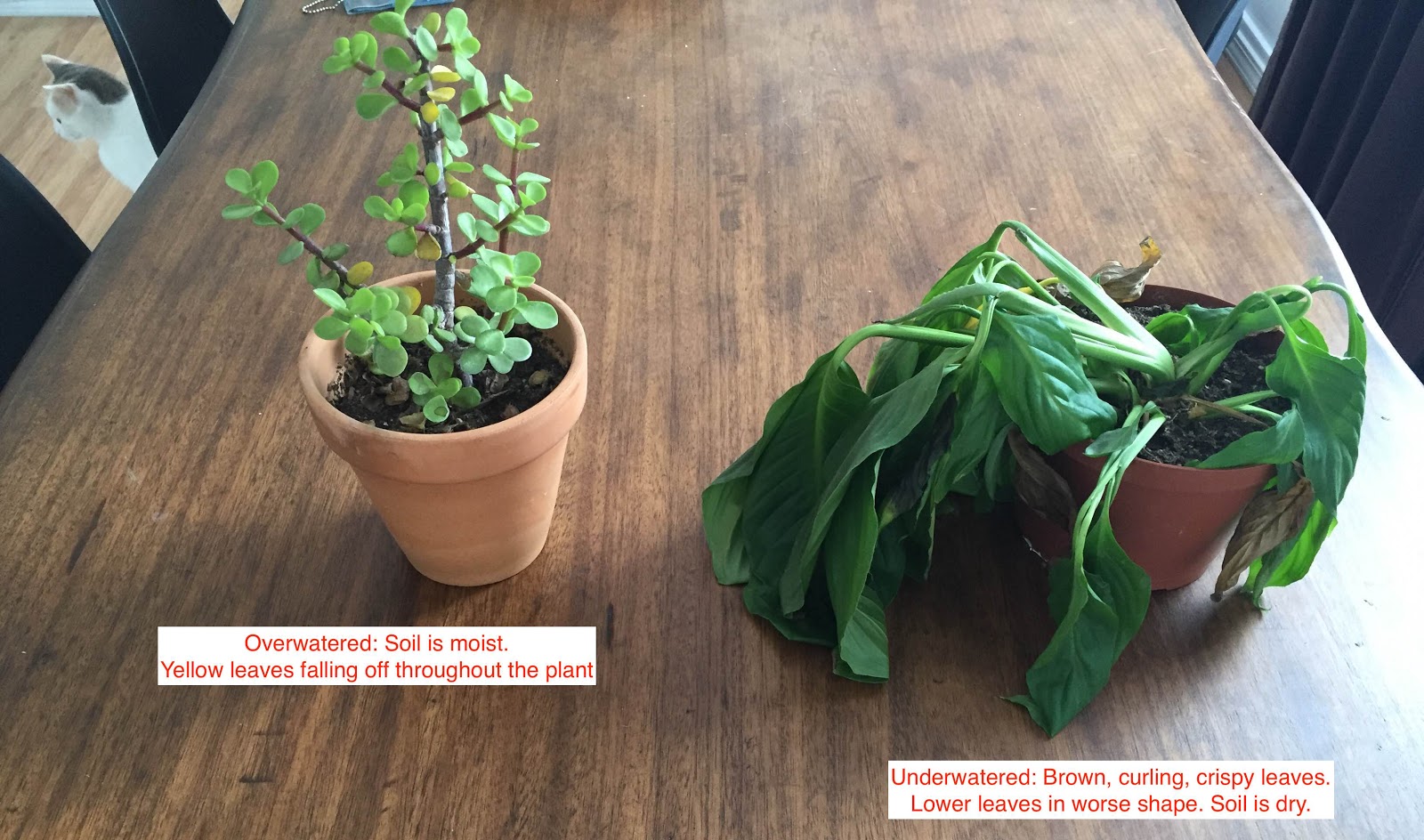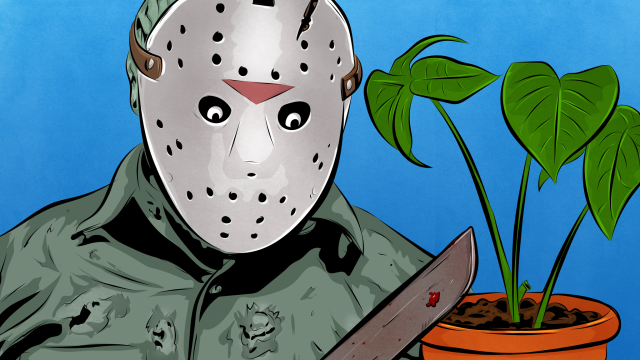Did you know a cactus could droop? I didn’t until I killed one. Some plants are hardier than others, but if you’re anything like me, the only plant that survives under your thumb is an artificial one. Habitual plant killers, here’s where we go wrong.
Illustration by: Sam Woolley
You’re Watering Them Wrong
Plant killers all know that “oh shit” moment where we realise something isn’t right. The plant starts drooping, and it looks a little yellowish brown. Or is that brownish yellow? Those are often signs of overwatering. The problem is, they’re also signs of underwatering. So how do you know if you’re watering too little or too much? Here are some symptoms unique to both, based on info from HomeGuides and Jain, an irrigation company.
Overwatering
- The base of the plant stem feels soft and mushy
- The tips of the leaves turn brown
- Yellow leaves throughout the plant that fall off
- The top 5cm of soil is moist
Underwatering
- The edges of the leaves are crispy and brown
- The leaves start to curl
- The lower leaves are in worse shape

When you examine the plant a little more closely, you should notice some subtle differences that tell you whether it’s drowning or thirsty.
If you’ve underwatered your plant, the solution is easy: water that thing! And tech can help with that. For example, with Waterbug (iOS) or Waterbot (Android), you enter details about your plant: what time it is, where you live and its average sunlight exposure. Based on that info, the app reminds you when your plant needs watering. It’s not foolproof, but if you’re bad with plants, the app is probably more reliable than your own judgment. You could also use a digital sensor like the Hydrofarm Thirsty Light to tell you when the soil is dry.
If you overwatered your plant, you’ll have to remove it from the soil to bring it back to life. HomeGuides offers step-by-step instructions for saving it, but the instructions boil down to cutting off the soft, rotten roots of the plant and repotting it in a pot with proper drainage.
Speaking of drainage, most plants need it, and when they don’t get enough, they get root rot. A hole at the bottom of your container may not be enough, either. The water needs a place to go, like over rocks or through a drainage tray. As the saying goes, give plants wet feet and dry ankles.
You Picked a Terrible Location
When you choose a place in your home for plants to live, pay attention to three main factors: lighting, temperature and humidity.
Lighting should be an obvious one — the requirements are right there on the plant’s tag. (And if there is no tag, you can look up the requirements using this online database). It can be confusing, though. Some plants require “low light”, but what exactly does that mean? How low is too low? The Sill suggests conducting a light test to figure it out. Find a shadow in the room, then use their guide to gauge the lighting situation:
- Well-defined shadow = bright light
- Fuzzy shadow, still recognisable as your hand = medium light
- Only faintly discernible shadow = low light
This should help you figure out the best spot for your plant, based on how much sun it needs, but the direction of the light is another useful measure:
South: Provides the most light; plants can be situated far into the room and still receive bright light.
East: Light drops off quickly; it’s best not to situate plants too far away from the window; a few feet into your room should be fine
West: Same light conditions as eastward facing windows but accompanied by more heat; keep plants near window, but draw a sheer curtain during mid-day sun
North: Provides the lowest light; your plants will be happiest right on the sill
If you have a darker home, consider these plants, which do well in low light. In fact, here’s an entire flowchart to help you pick the right plants based on your lighting environment.
As for temperature, most plants do well at temperatures between 18-24C, which is generally how cool most of us keep our homes. Pay attention to hot or cold spots in your home, though: right under a vent or near a blazing hot window, for example.
Finally, humidity is a factor in watering your plant, too. Some plants, like most ferns, thrive in really humid environments (like your bathroom) and need at least some humidity to survive. Look up the requirements for your specific greenery using a search tool like Garden.org’s Plants Database. If your moisture-loving plant is in a dry environment, spritz it with water every couple of days to make sure it’s getting the humidity it needs.
You’re Shocking Them
Change can be tough on any of us, and plants are no exception. When you take them home from the store and immediately shovel them into a new pot, in a new location, with even a slightly different temperature and lighting situation, they can experience transplant shock.
As Gardening Know How explains, if you want to prevent this, it comes down to the roots. Handle the root ball gently when transplanting and bring up as many of the roots as possible.
Sugar helps, too. A 2004 study published in the Journal of Arboriculture (PDF) found that feeding plants sugar can help reduce shock:
This finding indicates that the growth pattern of trees may be altered in favour of enhanced root formation by treating them during or immediately after transplanting with sugar, potentially offering a system for reducing tree mortalities due to transplant shock.
In the study, researchers drenched the roots in a water-sugar mixture (regular old grocery store sugar) at a concentration of either 25, 50 or 70g sugar per litre of water. When you transplant, add some sugar water to the mix, be careful with the roots and you should be in the clear.
You’re Using the Wrong Soil
Soil matters, so don’t just go to the garden store and grab a bag of whatever. Picking the right soil can get complicated, especially if you’re into gardening and you’re looking for plants to fruit and flourish. For those of us just trying to keep our potted green friends alive, Proven Winners suggests a few simple rules of thumb.
- Container potting soil should be light and fluffy.
- For containers, just use a regular potting mix. Look for a bag that says “Soilless potting mix”.
- Some plants, like orchids, need an especially good amount of drainage, so they have their own specialty potting mix.
Beyond the basics, there are some other factors to consider.
pH balance: The mix will usually tell you how acidic or alkaline the soil is on a scale from 0-14 (7 is neutral). Here are the ideal pH levels for some common houseplants. Most plants thrive in the 6.0-7.0 range, according to The Old Farmer’s Almanac.
Soil weight: Soil is typically classified by how dense it is: light, medium or heavy. As a basic rule of thumb, a medium soil is good for plants in full sun, because the soil holds water. Light soil works well for hanging plants or plants in indirect sunlight or shade. Heavy soils are typically used on outdoor plants, gardens and trees.
Organic vs. Nonorganic: As HomeGuides explains, organic potting mixes provide nutrients for plants over time. As their organic materials break down, they release nutrients. Nonorganic soil, on the other hand, contains enough fertiliser for a single season. After that, you might want to consider adding your own plant fertiliser.
Fertiliser: Speaking of fertiliser, it can be tricky. Adding too much can kill your plants, and as the New York Times notes, if the plant is thriving, it’s best not to bother. “If the plant is putting out new growth, is flowering or is growing well and looks strong, then it is doing well. Don’t push it.” However, they say plants that are growing under fluorescent light or have been sitting in the soil at stores could probably use a dose of fertiliser, and they recommend using a water soluble type with a ratio of 20-20-20, which is suitable for most houseplants.
There’s a lot more that goes into picking the right soil, but for the sake of simply keeping your plant alive, these basic rules should work. Finally, it helps to know how to read your plants to begin with. This way, you can pick up on early signs of suffering. Folia’s online plant database tells you what your plant’s leaf colour and blooms should look like when they’re healthy.
I envy my green-thumbed friends who seem to have an intuitive sense for making plants thrive. The rest of us can use these steps to troubleshoot the problem. Hopefully, you’ll be on your way to plants that may not thrive, but at least survive.

Comments
One response to “Why You Keep Killing Your Plants And What To Do About It”
It should be noted that in the Southern hemisphere, you should swap the North/South components for which side gets the most light.